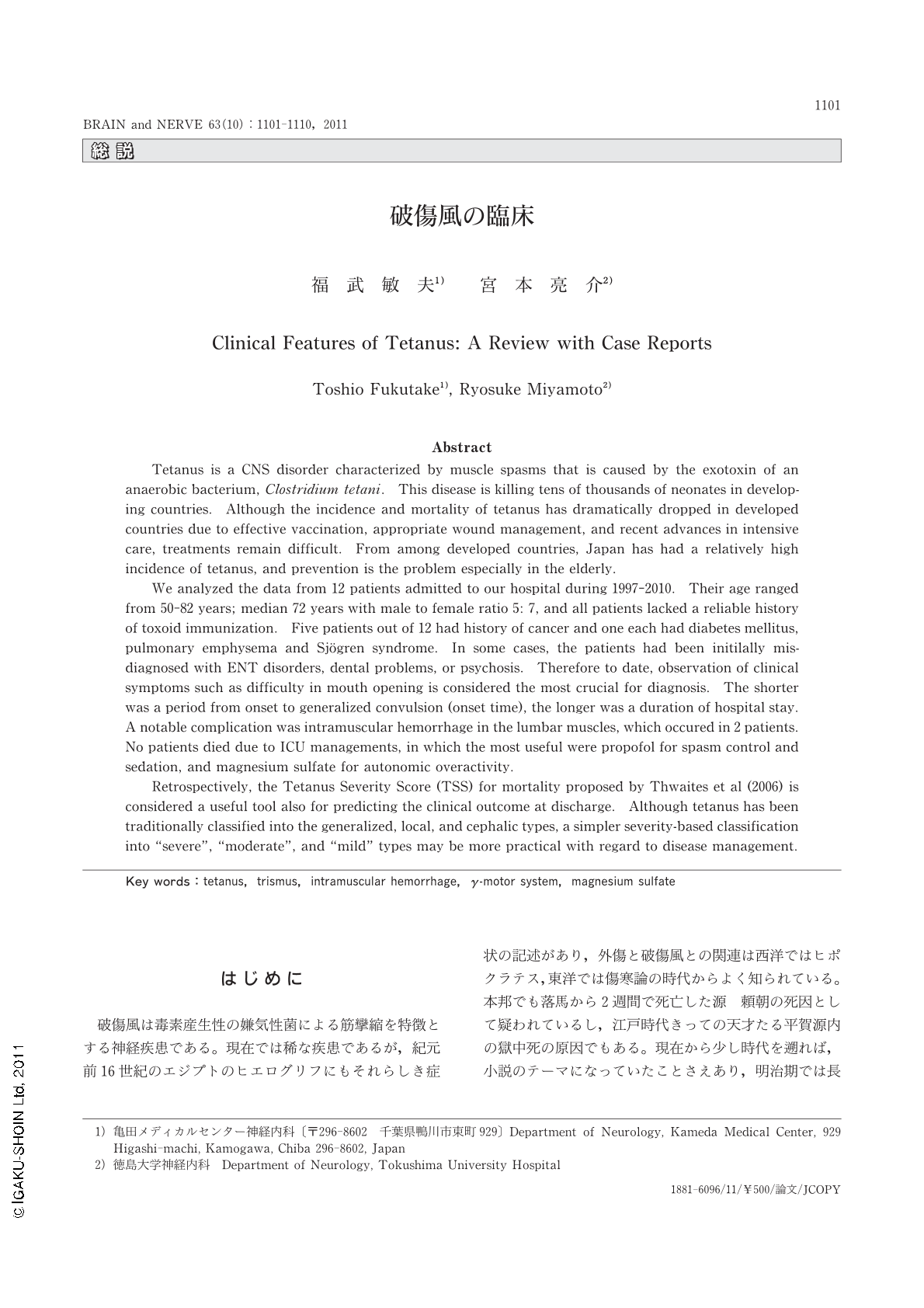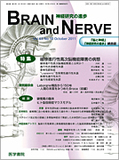Japanese
English
- 有料閲覧
- Abstract 文献概要
- 1ページ目 Look Inside
- 参考文献 Reference
はじめに
破傷風は毒素産生性の嫌気性菌による筋攣縮を特徴とする神経疾患である。現在では稀な疾患であるが,紀元前16世紀のエジプトのヒエログリフにもそれらしき症状の記述があり,外傷と破傷風との関連は西洋ではヒポクラテス,東洋では傷寒論の時代からよく知られている。本邦でも落馬から2週間で死亡した源 頼朝の死因として疑われているし,江戸時代きっての天才たる平賀源内の獄中死の原因でもある。現在から少し時代をさかのぼれば,小説のテーマになっていたことさえあり,明治期では長塚 節の『土』,昭和期でも三木 卓の『震える舌』がよく知られている1)。最近ふと手にした帚木蓬生の短編集『風花病棟』中の1編に「チチジマ」というのがある2)。少し長いが,破傷風の感染経路を考えるうえで示唆的と思われるので紹介する。
物語は1945年の硫黄島戦闘の際に,小笠原父島に遭難したアメリカ人パイロットと遠くから彼を目撃した日本人軍医との戦後の交流を描いたものである。2人の「再開」のきっかけは元軍医の国際医学会でのポスター発表であり,その演題は「臍の垢による破傷風の3例」であった。3例とも高齢者で,積もるまま放置していた臍の垢が感染巣になったという。昔から「臍の垢を洗うなかれ」という言い伝えがあるが,危険な迷信と思われる。
筆者らは2009年秋に開催された第14回日本神経感染症学会[会長:中野今治(自治医大神経内科教授)]のシンポジウムで破傷風について講演する機会を得た3)が,その年は北里柴三郎が破傷風菌の純粋培養に成功してから120年にあたっていた。北里は培養成功の翌年von Behringとともに抗毒素による免疫を発見し,治療への端緒をも切り拓いた1)が,残念にも1901年の記念すべき第1回ノーベル賞はvon Behringにしか与えられなかった。
その後1927年にRamonによって破傷風ワクチン(トキソイド)が作製され,その投与によって発症,致死率とも激減したが,破傷風は発展途上国では現在なお多くの新生児の死因となっており,先進国でも患者数は減ってはいるがなお治療が容易でない疾患である。特に本邦では最近,高齢者を主体に発生が増加傾向にある(Table1)4)。また,東日本大震災後のいわゆる瓦礫やヘドロの処理の過程で,破傷風が散発的に発生していると聞く。
本稿では今後の予防と治療について少しでも役立つようにと,筆者らの病院で最近経験した症例3,5)について報告するとともに,破傷風の臨床的事項について概説する。
Abstract
Tetanus is a CNS disorder characterized by muscle spasms that is caused by the exotoxin of an anaerobic bacterium, Clostridium tetani. This disease is killing tens of thousands of neonates in developing countries. Although the incidence and mortality of tetanus has dramatically dropped in developed countries due to effective vaccination, appropriate wound management, and recent advances in intensive care, treatments remain difficult. From among developed countries, Japan has had a relatively high incidence of tetanus, and prevention is the problem especially in the elderly.
We analyzed the data from 12 patients admitted to our hospital during 1997-2010. Their age ranged from 50-82 years; median 72 years with male to female ratio 5: 7, and all patients lacked a reliable history of toxoid immunization. Five patients out of 12 had history of cancer and one each had diabetes mellitus, pulmonary emphysema and Sjögren syndrome. In some cases, the patients had been initilally misdiagnosed with ENT disorders, dental problems, or psychosis. Therefore to date, observation of clinical symptoms such as difficulty in mouth opening is considered the most crucial for diagnosis. The shorter was a period from onset to generalized convulsion (onset time), the longer was a duration of hospital stay. A notable complication was intramuscular hemorrhage in the lumbar muscles, which occured in 2 patients. No patients died due to ICU managements, in which the most useful were propofol for spasm control and sedation, and magnesium sulfate for autonomic overactivity.
Retrospectively,the Tetanus Severity Score (TSS) for mortality proposed by Thwaites et al (2006) is considered a useful tool also for predicting the clinical outcome at discharge. Although tetanus has been traditionally classified into the generalized,local,and cephalic types,a simpler severity-based classification into "severe","moderate",and "mild" types may be more practical with regard to disease management.

Copyright © 2011, Igaku-Shoin Ltd. All rights reserved.


